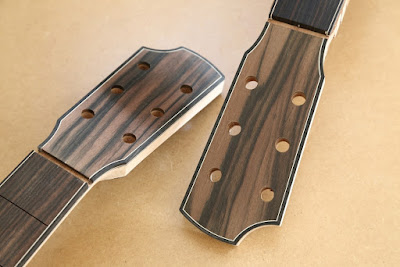Over the years, I've given a lot of thought to developing a signature look for my guitars and, for the most part, I'm satisfied with that aspect of their construction. Having said that, I'm sure there will be further evolution, as well as minor variations from one instrument to the next.
It's probably inevitable that with the limited canvas afforded by the guitar I'll often find instances of others' instrument designs having arrived at a similar destination in an aesthetic sense; my initial reaction when I discover that the headstock, heel cap, bridge shape or rosette design I invested so much time on exists elsewhere is one of mild disappointment. However, rather than seeking to change my own designs and embark on an endless exercise in tail chasing, I'm learning to accept that there's nothing new under the sun, and that there's no point in pursuing that particular mirage - no good can come from it, and constant disappointment can be the only predictable outcome!
As much as I admire design elements such as, for example, Kevin Ryan's "acoustic flutes", Michael Greenfield's ever-so-cool bridge shape, or Sheldon Schwarz's multiple oval soundholes, they strike me as truly unique designs that help identify those builders' instruments - part of their "brand", if you like. Although they're very inspiring, out of admiration and respect I would never seek to imitate those examples. Instead, I'll continue to be receptive to new ideas that drift into my consciousness, rejecting any that tend towards deliberate mimicry - assuming that I know they do!
With that in mind, I have some exciting "new" design features brewing that will unfortunately only see the light of day once I've built my workshop. I can't wait to turn them into reality!
Pete
























